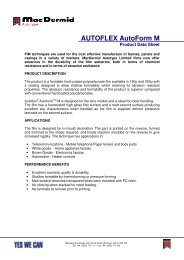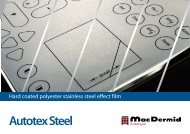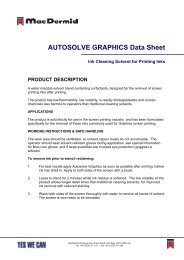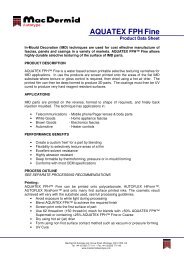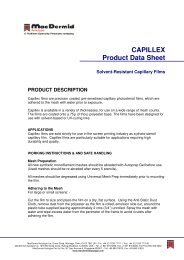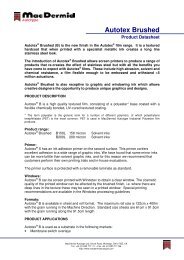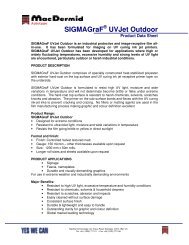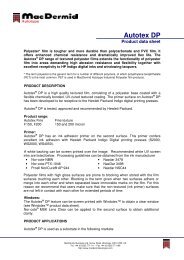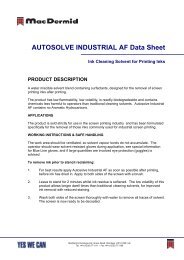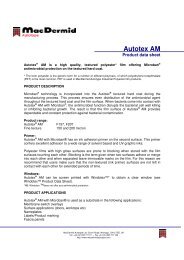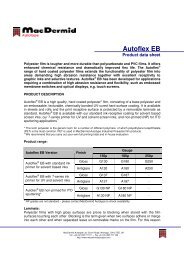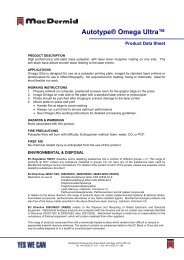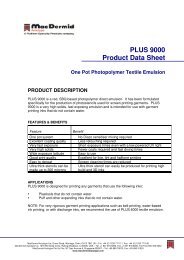Screen E-Book (.PDF) - MacDermid Autotype
Screen E-Book (.PDF) - MacDermid Autotype
Screen E-Book (.PDF) - MacDermid Autotype
- No tags were found...
You also want an ePaper? Increase the reach of your titles
YUMPU automatically turns print PDFs into web optimized ePapers that Google loves.
Solving problemsThe simple act of removing a sheet of filmfrom a stack, or passing a film through arubber roller nip produces static by separationand friction.Static is hard to eliminate once it has beenproduced so the best thing to do is to reducethe chances of creating it. An environmentwith a relative humidity greaterthan 50% helps. Reduce handling andrubber-roller nips to a minimum.Then make sure you have anti-static devicesat critical positions. An ionising air-gunis useful for spot work (especially for thefinal cleaning of a screen). An ionising airsysteminstalled on a press keeps criticalareas static free. And although “Christmastinsel” does a reasonable job of removingstatic, it doesn’t look too professional and iseasily broken; modern anti-static bungeecordsare a better alternative.The wrong meshWe’re astonished at how often printerschoose the wrong mesh. The most commonerror is to use white mesh, then complainabout lack of resolution. Next is aninappropriate choice of mesh-count anddiameter. What is puzzling about this isthat the choice should be very simple. Ifthe print contains large blocks of openimage then desired ink deposit can onlycome from a relatively small number ofmeshes – too coarse and the deposit istoo large, too fine and the deposit is toothin. If the print contains lots of fine detailthen the rule-of-thumb “2.5x the threaddiameter is the minimum size of printablefeature” gets you fairly close to the rightanswer. For fine-line printing there is noalternative to the finest stainless mesh youcan handle. And if you are after accurateregistration then a stainless or liquid-crystalmesh are your most likely choices aspolyester simply does not have sufficientlong-term stability.The other aspect of mesh choice is moresubtle. You must avoid mesh moiré. Fortunately,the Mesh Moiré Calculator (see thesection on moiré) helps you find the rightmesh-count for your 4-colour settings.As most high-resolution screen printersare moving to stainless, there’s one moretip we’ve learned from our most advancedcustomers. Get hold of blackened stainlessmesh as this has a dramatic effect onimproving resolution. It’s currently hard toget hold of, but the more customers whodemand it, the more the stainless meshmanufacturers will start to supply it.Image too close to the frameIf you have a few mm snap-off (off-contact),the pressure from the squeegee neededto force the mesh into contact with thesubstrate might be modest in the middleof the mesh, but will be higher when thesqueegee gets close to the edge of theframe. This comes from simple geometry.Middle of themesh, relatively lowpressure required,medium distortion74



